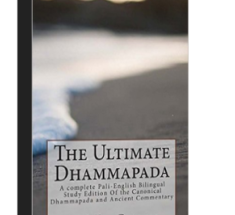 One might wonder how and why the modern vipassana movement experienced its revival just over a century ago in Burma.
One might wonder how and why the modern vipassana movement experienced its revival just over a century ago in Burma.
Looking back at 19th century Theravada countries, we can observe a widespread renaissance of Pali studies. This period saw the emergence of the first printing presses and Asian publishers, driven by growing national identity and aspirations for independence. These developments facilitated the rapid dissemination of Buddhist texts and supported Buddhist causes. Burma’s excellence in Pali studies served as an inspiration for Thailand and Sri Lanka. While the study of commentaries enhanced scholarly knowledge, practically-minded monks soon turned their attention to the Visuddhimagga.
This transition is particularly evident in old Sri Lankan temples. Their libraries contain remarkable collections of printed Pali texts, all dating from around the same period as Burma’s vipassana revival. As this initial Buddhist reformation gained momentum (partly in response to persistent Christian missionary activities), the Visuddhimagga, with its detailed chapters on samatha and vipassana meditation, became a focal point of interest.*
The Visuddhimagga (“Path to Purity”) offers comprehensive guidance not only on concentration meditation—providing clear starting points—but also on insight meditation, with detailed explanations of its characteristics in later chapters.
Reading the Visuddhimagga, whether in Pali or translation, remains a challenging endeavor, often laden with scholastic complexities. However, studying it in Pali offers a unique advantage: Many implicit connections become apparent with prior knowledge of the suttas and their terminology. These subtle references are often harder to detect in translation (which must navigate both dry scholasticism and commentarial grammar), though Ven. Ñāṇamoli’s footnotes provide excellent guidance in this regard.
This became particularly clear to me recently while reading the chapter on Bhanganupassana in Pali. My initial reaction was one of surprise—it felt like discovering a different text entirely!
This is where the journey starts:
738. Puna udayabbayañāṇe yogo kimatthiyoti ce? Lakkhaṇasallakkhaṇattho. Udayabbayañāṇaṃ hi heṭṭhā dasahi upakkilesehi upakkiliṭṭhaṃ hutvā yāthāvasarasato tilakkhaṇaṃ sallakkhetuṃ nāsakkhi. Upakkilesavimuttaṃ pana sakkoti. Tasmā lakkhaṇasallakkhaṇatthamettha puna yogo karaṇīyo.
Again yoking to the insight of rising and falling has which purpose? The purpose of noting/labelling/marking the characteristics [lit. ‘Noting the Notables’].
Because before the insight of rising and falling was besmeared with the ten defilements one was unable to note/label/mark the three characteristics as they really are (as they appear)**.
The next paragraph is not that important for our discussion, but I added it anyway, this time in Bhikkhu Ñāṇamolis translation, just so you get the context…
739. Lakkhaṇāni pana kissa amanasikārā kena paṭicchannattā na upaṭṭhahanti? Aniccalakkhaṇaṃ tāva udayabbayānaṃ amanasikārā santatiyā paṭicchannattā na upaṭṭhāti. Dukkhalakkhaṇaṃ abhiṇhasampaṭipīḷanassa amanasikārā iriyāpathehi paṭicchannattā na upaṭṭhāti. Anattalakkhaṇaṃnānādhātuvinibbhogassa amanasikārā ghanena paṭicchannattā na upaṭṭhāti. Udayabbayampana pariggahetvā santatiyā vikopitāya aniccalakkhaṇaṃ yāthāvasarasato upaṭṭhāti. Abhiṇhasampaṭipīḷanaṃ manasikatvā iriyāpathe ugghāṭite dukkhalakkhaṇaṃ yāthāvasarasato upaṭṭhāti. Nānādhātuyo vinibbhujitvā ghanavinibbhoge kate anattalakkhaṇaṃ yāthāvasarasato upaṭṭhāti.
Now the characteristics fail to become apparent when something is not given attention and so something conceals them. What is that? Firstly, the characteristic of impermanence does not become apparent because, when rise and fall are not given attention, it is concealed by continuity. The characteristic of pain does not become apparent because, when continuous oppression is not given attention, it is concealed by the postures. The characteristic of not self does not become apparent because, when resolution into the various elements is not given attention, it is concealed by compactness.
However, when continuity is disrupted by discerning rise and fall, the characteristic of impermanence becomes apparent in its true nature. [See our discussion on this in a prior posting]. When the postures are exposed by attention to continous oppression, the characteristic of pain becomes apparent in its true nature. When the resolution of the compact is effected by resolution into elements, the characteristic of not-self becomes apparent in its true nature.***
740. Ettha ca aniccaṃ, aniccalakkhaṇaṃ, dukkhaṃ, dukkhalakkhaṇaṃ, anattā, anattalakkhaṇanti ayaṃ vibhāgo veditabbo. Tattha aniccanti khandhapañcakaṃ. Kasmā? Uppādavayaññathattabhāvā , hutvā abhāvato vā…
And here the following differences should be understood: the impermanent, and the characteristic of impermanence; the painful, and the characteristic of pain; the not-self, and the characteristic of not-self. Herein, the five aggregates are impermanent. Why? Because they rise and fall and change, or because of their non-existence after having been.
‘‘Yadaniccaṃ taṃ dukkha’’nti (saṃ. ni. 3.15) vacanato pana tadeva khandhapañcakaṃ dukkhaṃ. Kasmā? Abhiṇhapaṭipīḷanā…
Those same five aggregates are painful because of the words: “What is impermanent is painful”. Why? Because of continuous oppression.
‘‘Yaṃ dukkhaṃ tadanattā’’ti (saṃ. ni. 3.15) pana vacanato tadeva khandhapañcakaṃ anattā. Kasmā? Avasavattanato, avasavattanākāroanattalakkhaṇaṃ.
Those same five aggregates are not self because of the words “What is painful is not self”. Why? Because there is not exercising of power over them.
So far so good. Now comes another important paragraph:
Tayidaṃ sabbampi ayaṃ yogāvacaro upakkilesavimuttena vīthipaṭipannavipassanāsaṅkhātena udayabbayānupassanāñāṇena yāthāvasarasato sallakkheti.
The diligent practicioner (yogāvacaro) notes (sallakkheti) all of this (tay’idam sabbampi) as it presents itself (yāthavasara-sato) ** with a knowing and observation of the rising and falling, that is free from defilements (upakkilesa) and that is an insight which follows the path.
 From a vipassana meditation standpoint the translation of this last paragraph makes sense. We continue noting (labelling/marking – sallakkheti) as “impermanent” etc. whatever our mind goes to (experiences) or whatever enters our mind.
From a vipassana meditation standpoint the translation of this last paragraph makes sense. We continue noting (labelling/marking – sallakkheti) as “impermanent” etc. whatever our mind goes to (experiences) or whatever enters our mind.
The continuity of doing so has become possible because we overcame certain mental defilements which blotted our ability to continuously observe. Furthermore our knowing is observing the arising and disappearing and the clear sight (vipassana) is following with the practice.
The Visuddhimagga elegantly bridges the gap between the suttas’ description of the insight process and the noting technique later revitalized by Mahasi Sayadaw.
This understanding becomes even more profound as we turn to the next passage:
Bhaṅgānupassanāñāṇakathā
741. Tassevaṃ sallakkhetvā punappunaṃ ‘‘aniccaṃ dukkhamanattā’’ti rūpārūpadhamme tulayato tīrayato taṃ ñāṇaṃ tikkhaṃ hutvā vahati, saṅkhārā lahuṃ upaṭṭhahanti, ñāṇe tikkhe vahante saṅkhāresu lahuṃ upaṭṭhahantesu uppādaṃ vā ṭhitiṃ vā pavattaṃ vā nimittaṃ vā na sampāpuṇāti. Khayavayabhedanirodheyeva sati santiṭṭhati. Tassa ‘‘evaṃ uppajjitvā evaṃ nāma saṅkhāragataṃ nirujjhatī’’ti passato etasmiṃ ṭhāne bhaṅgānupassanaṃ nāma vipassanāñāṇaṃ uppajjati.
Now, this is a pretty powerful paragraph. It starts out like this:
Having thus noted/marked, again and again weighing and examining form- (object) and non-form- (subject) related things thus: “impermanent, painful, not self”, he proceeds, his knowing having become really swift, and the formations establish (themselves) lightly/easily; and, while his knowledge is fast and the formations appear easily he does not obtain the rising, staying, persisting nor object. Quite contrary his sati establishes itself firmly in the destruction, cessation, breaking up and cessation.
For him who sees thus: “So having come into being so namely these formations cease” in this state the vipassana insight called ‘Observation of Breaking up’ arises.
{Here, for comparison purposes, Ñāṇamolis translation. It is really an excellent translation, but does not attach any importance to the way the punappunaṃ ‘‘aniccaṃ dukkhamanattā’’ti is being used.}
>>When he repeatedly observes in this way, and examines and investigates material and immaterial states, [to see] that they are impermanent, painful, and not self, then if his knowledge works keenly, formations quickly become apparent.<<
{whereas slightly more literal it would read: again and again weighing … thus: “impermanent, painful, not self”.}
So, one paragraph before Buddhaghosa tells us that a diligent practicioner (yogāvacaro) notes/labels/observes/marks (sallakkheti) all of this (tay’idam sabbampi) as it presents itself (yāthavasara-sato)**. He was referring to the suttas ‘‘Yaṃ dukkhaṃ tadanattā’’ti formula of explaining the observation of the three characteristics but in this powerful passage he ties those two ideas closer together and says that
of this (tay’idam sabbampi) as it presents itself (yāthavasara-sato)**. He was referring to the suttas ‘‘Yaṃ dukkhaṃ tadanattā’’ti formula of explaining the observation of the three characteristics but in this powerful passage he ties those two ideas closer together and says that
Tassevaṃ sallakkhetvā, punappunaṃ ‘‘aniccaṃ dukkhamanattā’’ti tīrayato
For him who thus noted, again and again observing so: “imperment, dukkha, non-self”.
…eventually the insight knowledge of bhanga or dissolution arises….(which, BTW quite a few among readers of this blog have probably experienced in their own vipassana meditation. Here a short “contemporary” word on this insight experience by Mahasi Sayadaw:
At such a stage, the arising of formations, that is, the first phase of the process, is not apparent (as it is in the case of knowledge of arising and passing away), but there is apparent only the dissolution, that is, the final phase, having the nature of vanishing. Therefore the meditator’s mind does not take delight in it at first, but he may be sure that soon, after becoming familiar (with that stage of the practice), his mind will delight in the cessation (of the phenomena) too, which is called their dissolution. With this assurance he should again turn to the practice of continuous noticing. [Mahasi Sayadaw, Progress of Insight, Chapter 6]
So our current meditative experience using a noting system as an approach to establish our attention/witnessing (sati) of the five groups of grasping seems quite in line with the Visuddhimaggas explanation at this point.
And the Visuddhimagga draws a direct connection between this insight activity and the “seeing and knowing of the rising and falling” as mentioned in the suttas, where it is said that this type of insight into impermanence serves as a trigger to the process of enlightenment. If this is the case, than the idea of a meditation as expressed in such lines as
‘‘Sukhaṃ vā yadi vā dukkhaṃ, adukkhamasukhaṃ saha;
Ajjhattañca bahiddhā ca, yaṃ kiñci atthi veditaṃ.
‘‘Etaṃ dukkhan” ti ñatvāna, mosadhammaṃ palokinaṃ;
Phussa phussa vayaṃ passaṃ, evaṃ tattha virajjatī’’ti.Whatever there is that can be felt/experienced, inside or outside,
Pleasure or pain, or neither pleasure nor pain;
Having known it so: “This is painful” of deceptive nature, disolving
In every moment of contact (“phussa, phussa” – lit. “touched, touched”)
Seeing its passing away, thus he there becomes disenchanted.[Sutta Nipāta, Dvayatānupassana Sutta, v. 743, en]
..is exactly as what the Visuddhimagga sees here too: a description of meditation, rather than just a philosophical statement. A sujet for and application of meditation rather than a religious dogma or purely philosophical statement.
While we happen to be at this point: The Visuddhimagga then goes on to quote the Patisambhidamagga and makes a profound remark:
‘‘Kathaṃ ārammaṇapaṭisaṅkhā bhaṅgānupassane paññā vipassane ñāṇaṃ? Rūpārammaṇatā cittaṃ uppajjitvā bhijjati, taṃ ārammaṇaṃ paṭisaṅkhā tassa cittassa bhaṅgaṃ anupassati.
How is the observation of the breaking up of objects a knowledge with regard to insight?
The mind too, which has the form as its object, arises and breaks up. He watches the breaking up of that mind which (just) observed the breaking up of a form object.
 This is really quite an amazing thing to watch/experience in vipassana. As these old texts (the Patisambhidamagga was probably canonized around 150-200 years after the Buddha) highlight it is quite a show and a sign of an advanced state of mindfulness and skill in observation to be so un-fooled by the mind that one is even able to see the impermanence of the “watcher”. The Visuddhimagga adds:
This is really quite an amazing thing to watch/experience in vipassana. As these old texts (the Patisambhidamagga was probably canonized around 150-200 years after the Buddha) highlight it is quite a show and a sign of an advanced state of mindfulness and skill in observation to be so un-fooled by the mind that one is even able to see the impermanence of the “watcher”. The Visuddhimagga adds:
Tassa cittassa bhaṅgaṃ anupassatīti yena cittena taṃ rūpārammaṇaṃ khayato vayato diṭṭhaṃ, tassa cittassa aparena cittena bhaṅgaṃ anupassatīti attho. Tenāhu porāṇā ‘‘ñātañca ñāṇañca ubhopi vipassatī’’ti.
“He watches the breaking up of that mind” – having seen the cessation and dissappearing of the form object with his mind, he watches in the next moment (aparena, later) that particular mind’s breaking up. Therefore the ancient meditation masters (porāṇā) have said: “He sees clearly both: the known and the knowing”
So cool 🙂 It sounds like a ZEN koan:
ñātañca ñāṇañca ubhopi vipassatī
The known and the knowing – both of which he sees clearly.
Something you can imagine an old hermit monk to have said to his disciples, which was later recorded in the Patisambhidhamagga and is now referenced by Buddhaghosa. Which is true for many other hints these late canonical and early none canonical texts give us with regards to early Buddhist meditation practice.
======Notes=====
*The influence of the Visuddhimagga was so profound that you can find old Sinhalese editions with interlinear translations, alternating between Sinhala and Pali either line by line or in parallel columns.
**yāthāvasarasato – a very interesting term.
However, the fascinating rendering of yāthāvasarasato as yatha-avasara-sato needs some backing. The PED simply translates it as “to see things as they really are” interpreting it as “yathava-sarasato”. Ñāṇatiloka and Ñāṇamoli translate it in this way too.
This might remind you of the discussion on this blog on a very similar term, used by the Buddha, “yathabhuta” were I was arguing that while “as it really is” is not completely wrong, there could also be something more meditation-relevant be implied. Every time you perceive an object in your vipassana meditation it is only after the fact (when it has already become “bhuta”, i.e. “when it appeared”, “has come into existance”) that you note it. But this is the point were you have to note it immediately – stopping the mind from falling into papañcā…its creative tendency to place subject and object apart and spin a story around them.
was arguing that while “as it really is” is not completely wrong, there could also be something more meditation-relevant be implied. Every time you perceive an object in your vipassana meditation it is only after the fact (when it has already become “bhuta”, i.e. “when it appeared”, “has come into existance”) that you note it. But this is the point were you have to note it immediately – stopping the mind from falling into papañcā…its creative tendency to place subject and object apart and spin a story around them.
Let’s check some other places where this term appears:
399. Sammappaññāya sudiṭṭhanti hetunā kāraṇena vipassanāpaññāya yāthāvasarasato diṭṭhaṃ.
which the sub-commentary explains as “Yāthāvasarasato diṭṭhanti yathābhūtasabhāvato paccakkhaṃ viya.”
So it is really being perceived as a synonym for yathābhūta and depending on how you interpret that word it might just simply mean “as it really is” or, focusing more on the subjective side of things, “as it found entrance”/”came into” (your mind), i.e. “appears to you”, “manifested itself to you”.



